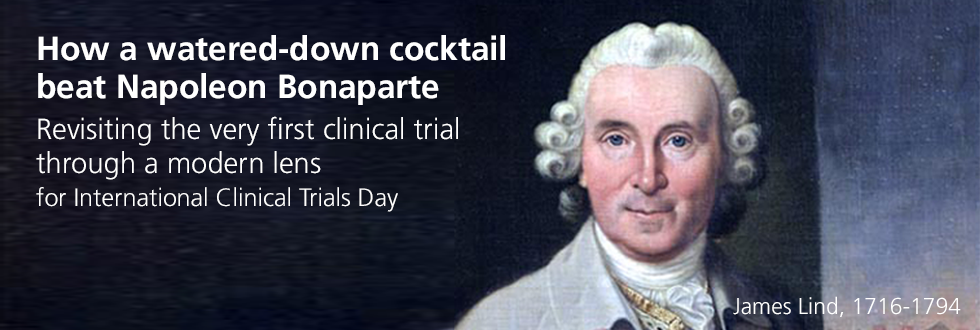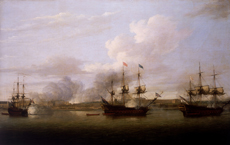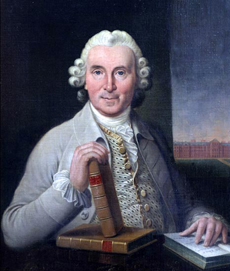By Douglas Drake
More of Clinerion's celebration of International Clinical Trials Day >
|
|
What shall we do with a drunken sailor, – British Royal Navy sea shanty, early 1800s |
| By the early 1700s, the oceans and sailing had become the path toward global expansion, global economics, and trade. Great Britain, France and Spain were vying for world domination through control of the sea, trade routes and colonies. |
|
There were, however, two problems with long voyages and time aboard. Number one was water purity. Water in wooden barrels would go bad after a few weeks on board. Number two was “scorbutic disorders which are contracted by salt diet and long voyages.” Scurvy, due to the lack of vitamin C in the diet, was a debilitating and often fatal condition that claimed more lives during long sea voyages than actual battle or the conditions on board. The British cured both and became the world’s greatest navy at Trafalgar, defeating both the French and Spanish armadas in 1805. This ultimately forced Napoleon into land battles on the Iberian Peninsula and Russia to enforce his continental system blockade of trade with the United Kingdom. The conclusion of which was a Number 1 hit for ABBA, “Waterloo.” |
|
|
|
The first English navy cure, starting in 1655, was a daily portion of beer and eventually rum to all sailors on ship, as the alcohol content reduced bacterial and other water contamination. “Grog,” or watered-down rum, became a staple on British navy ships for over 200 years. “Up Spirits” was the bosun call when the rum ration was distributed, answered by “Stand fast the Holy Ghost!” The second solution was not so obvious and became the very first “unofficial” clinical trial. In 1747, James Lind, a Scottish surgeon, on board the HMS Salisbury, tested his theory that acids could prevent the symptoms of scurvy. He divided twelve sailors into six groups of two and administered different supplements to each group: cider, vitriolic elixir (diluted sulfuric acid), vinegar, sea water, two oranges and a lemon, or a purgative mixture (laxative). The citrus fruit ran out after six days, but the effects on the two test subjects in that group were obvious. One sailor returned to normal duty and the second got well enough to take care of the other patients. Sailors thought that acid content in citrus fruit was what cured scurvy and thus preferred limes with high acid content over lemons or oranges … and they became themselves known as “Limeys”. |
Back to the Future – what if?
If we were to go back in time in a modified DMC DeLorean (which would float) to the HMS Salisbury in mid-1747, how would we view the trial, risk factors, patient stratification, metrics for dosing, and patient follow up?
Observation 1: The HMS Salisbury as a clinical setting or the very first “float” and remote trial setting?
HMS Salisbury was a 50-gun fourth-rate ship of the line of the British Royal Navy, meaning it was smaller ship, but still required 300 sailors to fully man. Life on board for the sailors below deck was cramped, harsh and dangerous with worsening conditions the longer the ship was at sea without fresh provisions. In the 1700s, one did not join the navy to see the world, but if at the wrong place at the right moment, could often have been impressed on board a ship by press gangs hired to make the needed crew quota. Onboard life was strict and harsh due to onboard discipline, and dangerous, because of the sea, weather, and disease. Scurvy starts as a general malaise, weakness and confusion, anemia, gingivitis, putrid gums, and then open sores, abscesses, and ulcers, and eventually death by bleeding, internal hemorrhaging, or infection. During the Age of Sail (1571 to 1862) it was assumed that 50% of all sailors would die from scurvy during an extended sea voyage.
The HMS Salisbury in 1747 was no different. The ship was in the Bay of Biscay after eight weeks under sail and sailors were getting sick. Dr. Lind postulated that the malaise was due to lack of acids in the diet and decided upon an experiment. One-tenth of the crew by this time had scurvy, so he had 30 or 40 individuals to choose from. He picked 12:
|
|
'Their cases were as similar as I could have them. They all in general had putrid gums, the spots and lassitude, with weakness of the knees. They lay together in one place, being a proper apartment for the sick in the fore-hold; and had one diet common to all, viz., water gruel sweetened with sugar in the morning; fresh mutton broth often for dinner; at other times puddings, boiled biscuit with sugar etc.; and for supper barley and raisins, rice and currants, sago and wine, or the like.' – James Lind, A Treatise of the Scurvy, 1753. |
However, the weekly roll call shows at most one or two, and usually none, as sick during this entire voyage. Being sick was highly frowned upon as malaise was most likely laziness, and curable with a “cat o’ nine tails”.
So, Dr. Lind treated patients in situ, and without the aid of IoT and indirect monitoring methods. His only intervention into their daily routines was dietary supplements.
Observation 2: Were impressed sailors providing patient consent and permission to use their personal and private healthcare data?
Sailors of the era were essentially the property of the captain or ship master until the end of the voyage. Personal choice or individual opinion was not highly regarded or requested and if volunteered could be construed as an effort toward mutiny. If the impressed sailors were not clear as to the intent, then the captain and officers on board had full recourse to motivate and keep moral high – a good flogging never hurt a man until it killed him.
Observation 3: Did Dr. Lind seek ethical committee approval or was he, as the surgeon on the board in charge of the care of ship’s crew, an ethical committee of one?
|
At sea, the shipmaster was considered "next after God," because there was seldom anyone else aboard the ship with greater power. William Morris Barnes, a master himself, declared in his autobiography, "A captain when he's at sea, he's judge, jury and everything else; he has the law in his own hands. If a mutiny starts, he can shoot every man of them down to save the ship. And, of course, in some cases we may be called on to do it". – From the Maritime History Archive |
So, no, no ethical committee review required for this human testing, just consent of the captain who never made note of it in his journal.
Observation 4: Trial design – assumptions and testing through control groups.
Lind's experiment was a six-armed comparative trial of cider, elixir of vitriol, vinegar, sea water, oranges and lemons, and a purgative mixture. There was no control or placebo group. What was unique and done for the first time was the systematic design testing six different supplements at the same time, however without a control or placebo group, observed affects are only assumed to be due to the supplement and not conclusively determined.
Lind's experiment is only briefly described in his Treatise of the Scurvy, which was published six years later in Edinburgh in 1753. It was not until the 1794 voyage of the HMS Suffolk non-stop to India in 23 weeks during which the crew were given lemon juice in the daily grog portion resulting in no scurvy outbreaks that the necessary public awareness developed. In 1795, the British Royal Navy adopted citrus rations.
Conclusions
Vitamin C, or ascorbic acid (a compound word describing the remedial effects against scurvy), was not discovered until the 1930s by Dr. Albert Szent-Györgyi at Szeged University in Hungary, using – ironically – Hungarian Paprika. Vitamin C is important for connective tissue strength, especially collagen. The logical structure of Dr. Lind’s first efforts almost 200 years earlier had shown the key relationship between citrus and scurvy disease without identifying the actual key ingredient. Today, randomized clinical trials (RCTs) have become the key standard in mapping cause and effect relationships between treatment and disease that ultimately improve the lives of patients, their families and society as a whole. The RCT method for rigorous study and outcome design has become the global standard for clinical research and experimentation, all due to two oranges and a lime, the original daily dosing supplement Dr. Lind created to test for acidic affects against scurvy.
References:
- George Anson (Baron Anson), The History of Commodore Anson's Voyage round the World, etc. (1764)
- Catherine Price, “The Age of Scurvy” (2017), available at www.sciencehistory.org/distillations/magazine/the-age-of-scurvy
- The Maritime History Archive, available at https://mha.mun.ca/mha/mlc/articles/shipmasters
- Michael Bartholomew, “James Lind’s Treatise of the Scurvy (1753)” (2002), available at https://pmj.bmj.com/content/78/925/695
- Graham Sutton, “Putrid gums and 'Dead Men's Cloaths': James Lind aboard the Salisbury” (2003), available at www.ncbi.nlm.nih.gov/pmc/articles/PMC539665
- Andrew George, "How the British defeated Napoleon with citrus fruit" (2016), available at: https://theconversation.com/how-the-british-defeated-napoleon-with-citrus-fruit-58826
More of Clinerion's celebration of International Clinical Trials Day >









